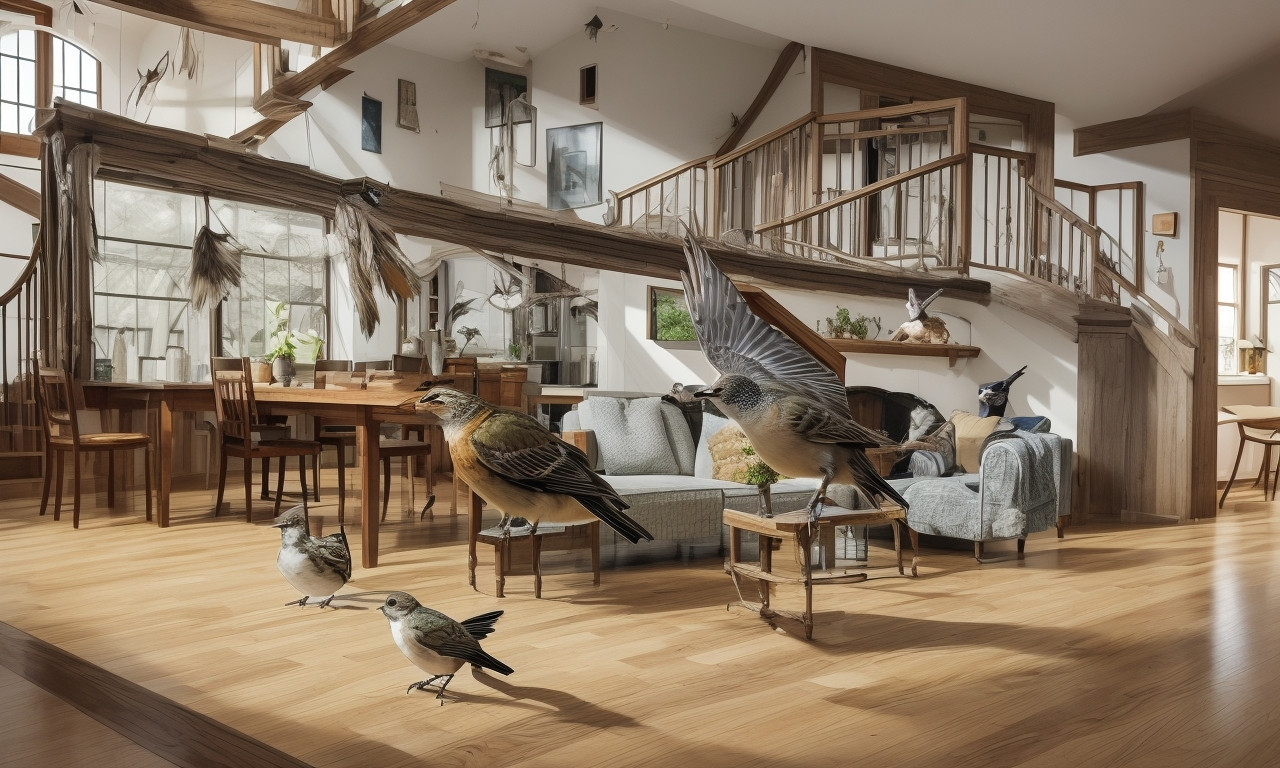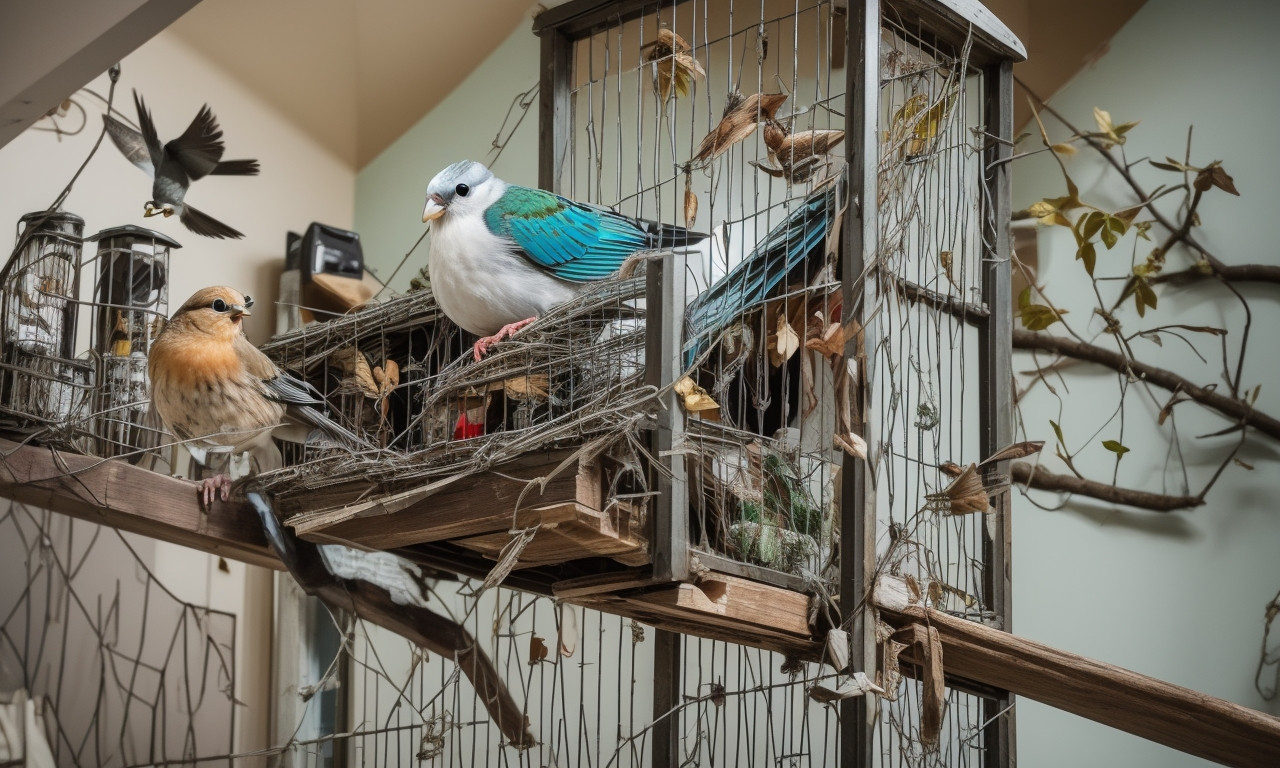How To Get A Bird Out Of Your House? Easy Steps Inside! Suddenly found yourself in a real-life game of cat and mouse, but with a bird? You’re not alone! Many homeowners face the unexpected challenge of a bird trapped inside their cozy abode. Before panic sets in, take a deep breath and read on. This guide will arm you with simple, effective strategies to gently and swiftly guide your feathered friend back to the great outdoors. Discover the foolproof methods that have worked for countless others—your peace of mind (and sanity) awaits!
Methods on how to get birds out of your house

Finding a bird unexpectedly inside your house can be quite startling, but with a few simple methods, you can guide the feathered visitor safely back outside. The first step in methods on how to get birds out of your house is to remain calm to avoid further distressing the bird. Gently close off other rooms to limit its roaming area. Open all windows and doors leading outside, ensuring a clear exit route.
Next, dim the indoor lights to make the outdoor light more inviting. Avoid any sudden movements; instead, use a slow approach to herd the bird toward the open exit. If the bird is perched or stationary, wave a lightweight sheet or pillowcase behind it to encourage flight without causing harm. Patience is essential, as abrupt actions might cause the bird to panic.
If the bird seems too stressed or unwilling to leave, consider using a box and a piece of cardboard. Carefully capture the bird using the box, then gently cover it with the cardboard. Transport the bird outside and release it far from dangers.
By using these effective methods on how to get birds out of your house, you can quickly turn a stressful situation into a simple and humane experience.
Isolate the bird in one room
Discovering a bird inside your house can be quite an unexpected event, but with a few easy steps, you can guide the feathered intruder safely back outside. Firstly, it’s crucial to remain calm and avoid startling the bird. To begin, try to isolate the bird in one room by closing all doors to prevent it from flying all over the house. This makes it far easier to direct the bird towards an exit.
Next, ensure all windows and doors leading outside in the isolated room are opened wide. Remove any screens to provide a clear and unobstructed path. Turn off any indoor lights and close curtains in other parts of the house to naturally guide the bird to the bright and open escape route.
Avoid attempting to catch the bird with your hands, as this can cause stress and potential harm. Instead, softly coax the bird towards the exit by gently waving your arms or using a soft broom to guide it. Maintain a calm demeanor to avoid further panic.
Patience is key; give the bird time to find its way out. By following these simple steps and ensuring you isolate the bird in one room, you can facilitate a safe and swift exit for your unexpected guest.
Turn off lights
Getting a bird out of your house can be a delicate task, but it can be done smoothly with a few simple steps. First, assess the situation and try to identify the bird’s location. It’s crucial to remain calm to avoid startling the bird further. Next, create a safe exit path. Open all windows and doors to provide the bird with a clear route to the outside. Importantly, turn off lights inside the room where the bird is trapped. Birds are naturally drawn to light, and turning off lights will encourage the bird to head toward natural daylight, which usually leads to the exit.
Using gentle movements, guide the bird toward the open window or door with a large piece of cloth or cardboard. Avoid making abrupt motions that could scare the bird. Calling in a friend or family member for assistance might also be helpful.
If the bird is perched high, you could try using a broom to coax it gently towards the exit, but always prioritize the bird’s safety and well-being. Remember, patience is key. Following these steps and remembering to turn off lights can ease the process, ensuring the bird safely finds its way out of your home.
Create a barrier using a bed sheet
Discovering a bird has flown into your house can be an unsettling experience, but removing it doesn’t need to be a daunting task. Begin by staying calm and eliminating any sudden movements that could scare the bird. First, ensure all exits are accessible by opening windows and doors. Darken the room slightly by drawing curtains or blinds, leaving the exit points well-lit to guide the bird out.
A crucial step is to create a barrier using a bed sheet. This method is effective for gently directing the bird without causing harm. Find the bird’s current location and, with the help of another person, hold the bed sheet taut between you. Slowly approach the bird, guiding it toward the open window or door. The bed sheet serves as a non-threatening wall that gently persuades the bird to move in the desired direction.
In addition, turn off any ceiling fans or other sources of potential injury for the bird. Be patient and give the bird time to understand the exit route. By following these steps, you can efficiently guide the bird out of your home safely. Remember, the key is to stay calm and use techniques like creating a barrier using a bed sheet to ensure a stress-free exit for the bird.
Tiring the bird out
Finding a bird inadvertently trapped inside your home can be a surprising event. While it might seem daunting, there are straightforward steps to guide you. Start by closing off any areas where the bird could potentially harm itself, such as kitchens and bathrooms. Calmly open all windows and doors to create an exit route.
Part of the process will involve tiring the bird out, which can be achieved by gently encouraging it to fly towards an open window or door. Use light movements or a soft cloth to steer the bird without intimidating or causing it stress. Avoid fast, sudden actions, as these may frighten the bird and prolong the effort.
Give the bird some time. After flying around, it will likely get tired, slowing down and becoming easier to guide. Ensuring other pets or children are in another room will offer the bird a calmer environment, aiding in its natural inclination to find the exit. Patience is essential. By remaining composed and persistent, the bird will eventually exhaust its energy reserves, making it more manageable to guide safely outside. Remember, tiring the bird out is a humane strategy, ensuring its prompt and stress-free return to the great outdoors.
Call in the experts
Discovering a bird has flown into your home can be a startling experience, but worry not—there are straightforward measures you can take to guide it outside safely. Start by remaining calm and creating an exit path for the bird. Open one window or door fully while closing others to direct the bird toward its way out. Turn off lights in other rooms to encourage the bird to move toward the natural light.
If the bird is not heading to the exit, gently usher it by slowly approaching and using a light object like a broom to guide its flight direction. Be careful not to swing or make sudden movements that could stress the bird.
Sometimes, despite your best efforts, the bird may remain elusive or frightened. In such cases, it’s wise to call in the experts. Wildlife professionals have the tools and knowledge to handle the situation delicately and ensure the bird’s safe removal. They can also provide tips to prevent future incidents, such as installing screens or sealing potential entry points.
By staying composed and following these easy steps, you can safely escort the bird from your home and avoid any harm to it or yourself.
Why do birds fly into houses?

Birds flying into houses can be both startling and stressful. Fortunately, there are effective ways to guide these feathered visitors back safely outdoors. The initial step involves remaining calm; your anxiety could further alarm the bird. Open windows and doors that lead outside, creating a clear and inviting exit. Make sure to remove any obstacles that might confuse or block the bird’s path. If the bird doesn’t find its way out, gently coax it by using a light cloth or towel, carefully approaching from behind and covering it lightly. Next, you can slowly carry it towards an open window or door and release it gently.
Prevention is equally crucial. Asking, “Why do birds fly into houses?” is essential to understanding how to avoid future avian incursions. Birds often enter homes unintentionally while searching for food or following reflective surfaces that mimic open skies. You can deter this by installing screens on windows and doors, using decals on glass surfaces to reduce reflections, and keeping food sources secured. Adding wind chimes or other gentle noise-makers near entry points can also discourage birds from venturing too close. By addressing these preventive measures, you can keep both your feathered friends and your household safe and undisturbed.
Which birds are the most common to fly into houses?

Removing a bird from your home may seem daunting, but with the right approach, it becomes a manageable task. Start by assessing which birds are the most common to fly into houses. Oftentimes, sparrows, pigeons, and starlings are the usual suspects due to their adaptability to urban environments. Once identified, ensure to stay calm to avoid startling the bird further.
First, create a safe exit by opening windows and doors, allowing the bird a clear path to escape. If necessary, turn off lights to encourage the bird toward the natural light outside. Use gentle guidance, such as a broom or towel, to direct the bird toward the exit without causing harm.
If these steps don’t work, try setting up humane bird traps with food as bait near the entrance. After capturing, carefully release the bird outdoors. Always wear gloves to protect both yourself and the bird during the process.
In preventing future incidences, consider installing screens on windows and chimneys. Additionally, understanding which birds are the most common to fly into houses can help in taking specific preventative measures tailored to deter those particular species.
By following these easy steps, you can safely and efficiently guide a bird out of your house, ensuring a stress-free experience for both you and your unexpected visitor.
What does it mean when a bird flies in your house?

Finding a bird unexpectedly flying inside your house can be both startling and challenging. If you’re confronted with this scenario, here are some straightforward steps to guide the bird back outside safely. First, remain calm. Panic could worsen the situation for both you and the bird. Begin by isolating the bird in one room, closing all other doors to minimize its confusion and possible harm. Open windows and doors to create an exit path, removing any obstacles that might obstruct the bird’s flight. Dim the lights inside while keeping the outdoor area well-lit to make the exit more inviting.
To gently nudge the bird towards the opening, use a soft approach like slowly waving a piece of cloth or gently herding it with a broom. It’s crucial to avoid making sudden movements. If these steps don’t help, you may need to carefully capture the bird using a lightweight towel, gently placing it outside to ensure its safety.
You may wonder, what does it mean when a bird flies in your house? Culturally, it varies, symbolizing anything from good luck to impending change. Regardless of beliefs, the primary focus should be on the bird’s safe removal. Through these simple actions, you can resolve the situation efficiently and compassionately.
Bird In House FAQs

Having a bird fly into your house can be quite an unexpected occurrence, but it’s manageable with some simple steps. First, the key is to stay calm. A frantic bird will already be stressed, so keeping your movements slow and quiet can prevent further chaos. Open all windows and doors to provide an easy escape route for the bird. Turn off any lights and close curtains to darkened pathways, naturally guiding the bird towards the exit.
You might need to patiently wait. Avoid trying to catch the bird with your hands, as this can injure it. Instead, if the bird doesn’t find its way out quickly, try gently coaxing it with a towel or a soft broom towards the exit. Remember to check behind curtains or furniture where a bird might hide.
Bird In House FAQs often include questions about preventing future intrusions. Ensuring screens on windows and doors are intact and keeping doors closed when not in use can help. Consistently check for any openings in your home where birds might get in. Educating yourself on Bird In House FAQs can prepare you for such incidents and aid in quickly resolving them while ensuring the bird’s safety and your peace of mind.
How do I get a bird out of my house with no windows?
Getting a bird stuck in your house can be a stressful experience, especially when there are no windows for an easy escape. If you’re wondering, "How do I get a bird out of my house with no windows?" there are several steps you can take to safely resolve the situation.
First, stay calm and avoid startling the bird further. Close all interior doors to confine the bird to one room, making the extraction process simpler. Turn off any lights in the house to make the exit area more appealing when it becomes available.
Find a large lightweight cloth or towel and gently approach the bird. Use the cloth to cover the bird, reducing the risk of injury to both you and the bird. Once the bird is securely covered, carefully pick it up, ensuring not to squeeze too tightly, and take it to the nearest door. Before releasing, double-check that the bird is unharmed.
If the bird is perched too high or in a place you can’t reach, try using a broom or long object to gently guide the bird towards the door. Patience is key, and remaining calm throughout the process will increase your chances of a successful and humane outcome.
In case you feel uncomfortable handling the situation yourself, don’t hesitate to contact local animal control or a wildlife rescue organization for professional assistance.
How do I get a bird out of the house at night?
Navigating the challenge of how to get a bird out of your house at night can be tricky but manageable with a few clear steps. First, stay calm to avoid startling the bird further. Switch off interior lights and ensure the outside area is brightly lit. Birds naturally navigate towards the light, so this contrast helps guide them outside. Gently close off doors to other rooms, confining the bird to one area to simplify its exit route.
If the bird remains flighty or disoriented, try opening windows or doors wide to create a visible path to freedom. Removing window screens can be beneficial as it offers easier passage. With minimal quick movements, approach slowly to avoid provoking more erratic flying. Sometimes, strategically placed birdseed near the exit can lure the bird toward the open air.
For added assistance, a light sheet can be used: gently toss it over the bird, then carefully carry it outside, ensuring not to harm it. If these efforts fail and you find yourself wondering, "How do I get a bird out of the house at night?" consider contacting local wildlife rescue for professional help. Remaining patient and calm is key to a successful and humane resolution.
How to get a bird out of your house with high ceilings?
Getting a bird out of your house can be a complex process, especially when dealing with high ceilings. The first step is to remain calm and keep any pets or children away to avoid startling the bird. Open all windows and doors to provide a clear path for the bird to escape. Use a broom or similar object to gently guide it towards the opened space.
When dealing with high ceilings, consider using long-handled tools to reach the bird if it perches out of immediate reach. If the bird is disoriented, dimming the lights can calm it and make open windows appear more appealing as exit routes.
Blocking off other areas of the house can help confine the bird to one room, making it easier to manage. Patience is crucial; avoid sudden movements that might cause the bird to fly erratically, complicating the situation.
For more persistent problems, professional wildlife rescuers can be contacted. They have the expertise to safely remove the bird without causing harm.
Knowing how to get a bird out of your house with high ceilings involves preparation, patience, and the right tools. Following these steps can ensure a safe and stress-free removal for both you and the feathered visitor.




